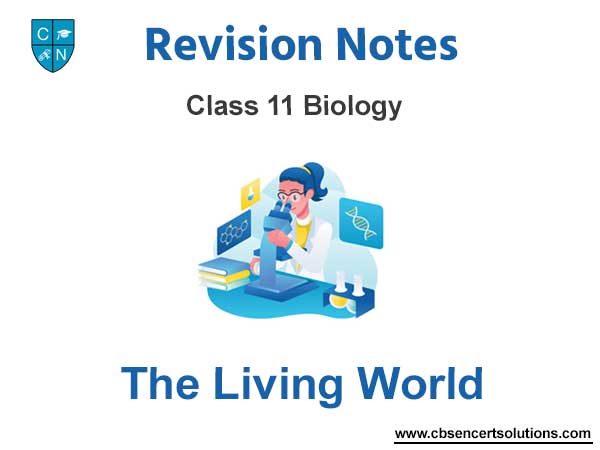Please refer to The Living World Class 11 Biology notes and questions with solutions below. These revision notes and important examination questions have been prepared based on the latest Biology books for Class 11. You can go through the questions and solutions below which will help you to get better marks in your examinations.
Class 11 Biology The Living World Notes and Questions
Points to Remember
1. Organism (Microorganism, plant and animals) who posseses life is living.
2. Life is a complex organisation expressing itself through chemical reactions and exhibit characteristics of living organisms.
3. Characteristics of Living Organisms : Growth, reproduction, metabolism, cellular organisation, consciousness (ability to sense environment), self replicating and self regulation.
- Reproduction and growth are NOT defining properties.
- Metabolism, cellular organisation and consciousness are defining properties.
- Living organisms are self-replicating, evolving, self-regulating and interactive systems capable of responding to external stimuli.
4. Biodiversity : Term used to refer to the variety of microorganisms, plant and animals on earth.
5. Need for classification : To organise the vast number of microorganisms, plants and animals into categories that could be named, remembered, studied and understood.
6. Three Domains of Life: Proposed by Carl Woese in 1990 who also proposed the six kingdom classification for living organisms. The three Domains of life are Archaea, Bacteria and Eukarya.

7. Taxonomy: Study of principles and procedures of identification, nomenclature and classification.
8. Systematics : It deals with classification of organisms based on their diversities and relationships among them. Term was proposed by Carolus Linnaeus who wrote ‘Systema Naturae’.
9. Concept of Species :All the members that can interbreed among themselves and can produce fertile offsprings are the members of same species. This is the biological concept of species proposed by Mayr.
10. Taxa: Each category (i.e., unit) of classification is called as a taxon.
11. Taxonomic Hierarchy : Classification of organisms in a defnite sequence of taxon or category or rank in a desending order.
King→domPhylum /Division→Class→Order→Family→Genus→Species.
12. Binomial Nomenclatm·e: Given by Carolus Linnaeus. Each scientific name has two components-Generic name+ Specific epithet.
13. ICBN: International Code for Botanical Nomenclature (for giving scientific name to plants.)
14. ICZN: International Code of Zoological Nomenclature (for giving scientific name to animals.)
15. Rule for Nomenclatm·e:
- Latinised names are used.
- First word is genus, second word is species name.
- Printed in italics; if handwritten then underlined separately.
- First word starts with capital letter while species name written in small letter.
16. Scientific names of some organisms :
Man — Homo sapiens
Housefly — Musca domestica
Mango — Mangifera indica
Wheat — Triticum aestivum
17. Taxonomical Aids are the tools for study of taxonomy.
18. Museums in educational institutes (school and colleges) have collection of skeletons of animals, stuffed and preserved specimens of organisms for study and reference.
19. Zoological Parks (Places where wild animals are kept in protected environment under human care) Example : National Zoological Park, Delhi.
20. Herbarium : Store house of dried, pressed and preserved plant specimen on sheets, kept systematically according to a widely accepted system of classification, for future use.
21. Botanical Garden : Collection of living plants for reference.
Example : Royal Batanical garden Kew (England), National Botanical
Research Institute (Lucknow), Indian Botanical Garden Howrah.
22. Keys: (Used for indentification of plants and animals on the basis of similarities and dissimilarities.)
23. Couplet: are the two alternate characteristic statement used in key to identify organisation.
24. Each Statement of the key is called a lead.
25. Flora (Index to plant species found in a particular area.
26. Manuals (Provide information for identification of name of species in an area.)
27. Mongoraphs (Contain information on any one taxon.)

We hope the above The Living World Class 11 Biology are useful for you. If you have any questions then post them in the comments section below. Our teachers will provide you an answer. Also refer to MCQ Questions for Class 11 Biology


